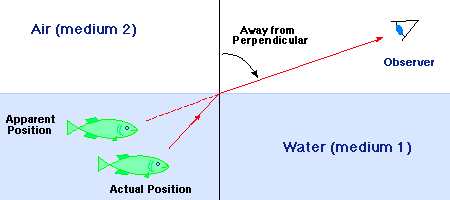


The phenomenon of refraction of sound in the atmosphere has been known for centuries however, beginning in the early 1970s, widespread analysis of this effect came into vogue through the designing of urban highways and noise barriers to address the meteorological effects of bending of sound rays in the lower atmosphere. Similar acoustics effects are also found in the Earth's atmosphere. The amount of ray bending is dependent on the amount of difference between sound speeds, that is, the variation in temperature, salinity, and pressure of the water. In underwater acoustics, refraction is the bending or curving of a sound ray that results when the ray passes through a sound speed gradient from a region of one sound speed to a region of a different speed. Conversely, the apparent height approaches infinity as the angle of incidence (from below) increases, but even earlier, as the angle of total internal reflection is approached, albeit the image also fades from view as this limit is approached. But, as the angle of incidence approaches 90 o, the apparent depth approaches zero, albeit reflection increases, which limits observation at high angles of incidence. įor small angles of incidence (measured from the normal, when sin θ is approximately the same as tan θ), the ratio of apparent to real depth is the ratio of the refractive indexes of air to that of water. The opposite correction must be made by an archer fish. Conversely, an object above the water has a higher apparent height when viewed from below the water. This is an important consideration for spearfishing from the surface because it will make the target fish appear to be in a different place, and the fisher must aim lower to catch the fish. The depth that the water appears to be when viewed from above is known as the apparent depth. This causes the pencil to appear higher and the water to appear shallower than it really is. The lines of sight (shown as dashed lines) intersect at a higher position than where the actual rays originated. Once the rays reach the eye, the eye traces them back as straight lines (lines of sight). This is due to the bending of light rays as they move from the water to the air. Looking at a straight object, such as a pencil in the figure here, which is placed at a slant, partially in the water, the object appears to bend at the water's surface. Refraction occurs when light goes through a water surface since water has a refractive index of 1.33 and air has a refractive index of about 1. Refraction in a water surfaceĪ pencil part immersed in water looks bent due to refraction: the light waves from X change direction and so seem to originate at Y. How much a wave is refracted is determined by the change in wave speed and the initial direction of wave propagation relative to the direction of change in speed.įor light, refraction follows Snell's law, which states that, for a given pair of media, the ratio of the sines of the angle of incidence θ 1 and angle of refraction θ 2 is equal to the ratio of phase velocities ( v 1 / v 2) in the two media, or equivalently, to the refractive indices ( n 2 / n 1) of the two media. Refraction of light is the most commonly observed phenomenon, but other waves such as sound waves and water waves also experience refraction. The redirection can be caused by the wave's change in speed or by a change in the medium. In physics, refraction is the redirection of a wave as it passes from one medium to another.

A ray of light being refracted in a plastic block.


 0 kommentar(er)
0 kommentar(er)
